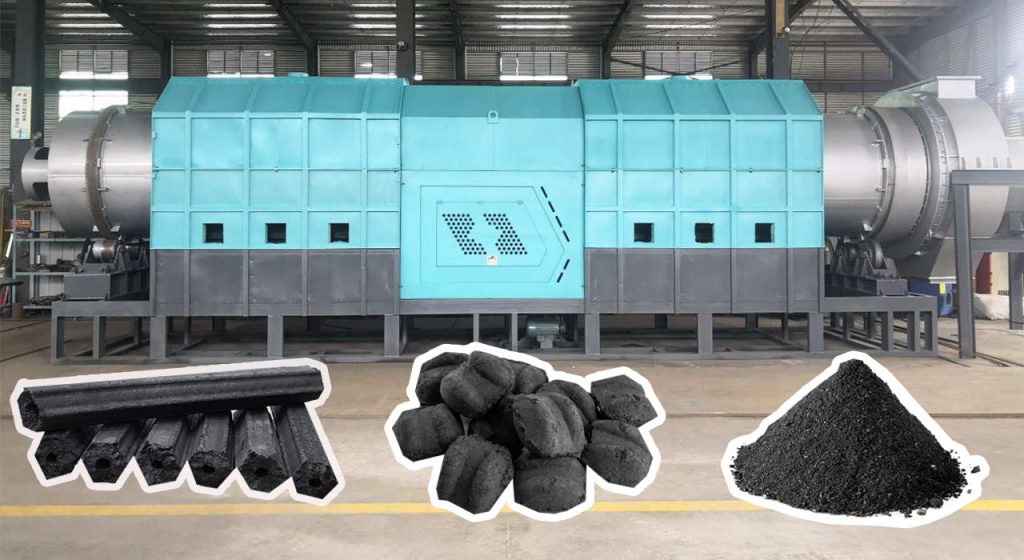In the world of sustainable practices and resourceful utilization, the art of charcoal making stands as a venerable craft, weaving together tradition and innovation. Beneath the seemingly humble surface lies a process laden with intricacies, transforming raw materials into the timeless fuel that has been a companion to humanity for centuries.
The Alchemy of Charcoal Making
A Fiery Genesis: Pyrolysis Unveiled
At the heart of charcoal making lies pyrolysis, a transformative process where wood, agricultural residues, or even coconut shells undergo a metamorphosis in the absence of oxygen. This controlled decomposition results in the expulsion of volatile compounds, leaving behind the carbon-rich essence we know as charcoal. The alchemy of pyrolysis is where the journey from raw material to fuel begins. The charcoal making machine is used to make charcoal.

Kiln Chronicles: Furnaces of Transformation
Within the craft, the kiln emerges as a central protagonist—a furnace where the raw materials face the crucible of heat. The kiln, be it traditional or modern, becomes the stage for the slow dance of pyrolysis, orchestrating the delicate balance of temperature and time. This is where the craft of charcoal making transcends mere science and embraces the nuances of an art form.
The Symphony of Raw Materials
Timber Tales: Wood as the Protagonist
In the annals of charcoal making, wood stands as the primary protagonist. The selection of timber is a nuanced decision, with different wood species imparting distinct flavors to the charcoal. From the smoky richness of mesquite to the subtle sweetness of fruitwood, each timber has its tale to tell within the symphony of charcoal making. More information on biochar machine here.
Residues Rewritten: Agricultural Waste and Beyond
The craft extends its embrace beyond wood, welcoming agricultural residues into its repertoire. Coconut shells, corn cobs, or even rice husks, each bears the potential to be reborn through pyrolysis. The utilization of these residues not only adds diversity to the craft but also repurposes materials that might otherwise be deemed waste.
Artisanal Techniques: From Tradition to Innovation
Ancient Wisdom: Traditional Charcoal Pits
In the realm of charcoal making, traditional charcoal pits exude an aura of ancient wisdom. Dug into the earth, these pits harness the power of the elements, utilizing the natural insulation of soil to regulate temperature. The slow, unhurried pace of this method imparts a unique character to the charcoal, embodying the spirit of time-honored craftsmanship.
Modern Marvels: Retorts and Continuous Pyrolysis
As the craft evolves, modern techniques weave themselves into the narrative. Retorts, with their enclosed chambers and efficient heat recovery, exemplify technological progress. Continuous pyrolysis systems bring a sense of automation, ensuring a steady output without sacrificing the essence of the craft. These innovations herald a new chapter in the history of charcoal making. See the biochar production equipment here.
Quality Charcoal: The Culmination of Craftsmanship
Charcoal Grading: A Fine Balance
Just as a connoisseur savors the nuances of wine, charcoal making artisans delve into the art of grading. From lump charcoal to briquettes, each variety caters to a specific purpose. The balance between density, carbon content, and burn time becomes a hallmark of quality craftsmanship.
Smoke Signals: The Aromas of Charcoal
In the world of culinary arts, the aromas of charcoal play a pivotal role. The type of wood, the nuances of pyrolysis, and even the residual flavors from the raw materials—all contribute to the symphony of scents that elevate the culinary experience. The craft of charcoal making, in essence, becomes a silent collaborator in the gastronomic journey.
Sustainability in the Embrace of Charcoal Making
Eco-friendly Charcoal: Turning Over a Green Leaf
As environmental consciousness takes center stage, charcoal making is not exempt from the imperative to be eco-friendly. Sustainable practices, from responsibly sourcing wood to utilizing agricultural waste, become guiding principles. The craft becomes a steward of the environment, proving that tradition and innovation can coexist in harmony.
Carbon Sequestration: A Hidden Benefit
Beyond its role as a fuel, charcoal becomes an unexpected ally in the fight against climate change. The carbon-rich essence of charcoal, when returned to the soil, becomes a form of carbon sequestration. The craft of charcoal making, often underestimated in its ecological significance, takes on a new dimension as a contributor to environmental balance. Visit the Beston Group here.
Conclusion: Crafting a Sustainable Legacy
As we traverse the realm of charcoal making, the craft unveils itself as more than a means to an end. It is a cultural tapestry woven through time, connecting traditions and innovations. From the ancient wisdom of traditional pits to the efficiency of modern retorts, each method leaves its imprint on the charcoal produced. The craft, in its entirety, becomes a legacy—a sustainable legacy that transcends generations, leaving an indelible mark on both the environment and human ingenuity.